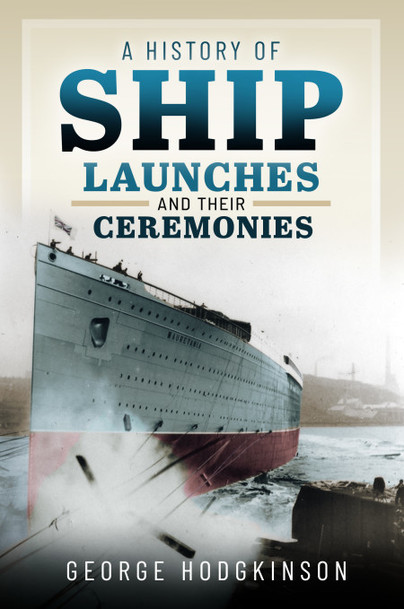Author Guest Post: George Hodgkinson
The King takes on the sponsorship of Royal Navy’s flagship HMS Queen Elizabeth
On 11 August Buckingham Palace announced that, following the death of Queen Elizabeth II, King Charles III has taken on the sponsorship of HMS Queen Elizabeth, the Royal Navy’s 65,000 ton aircraft carrier which is the Royal Navy ‘s flagship. The late Queen who named the carrier in Rosyth in July 2014 was the ship’s original Sponsor.
Typically the ‘sponsor’ of a naval ship is the lady who has been chosen to have the honour of naming the ship and for merchant ships is known as her ‘godmother’. The concept of sponsorship of naval ships is derived from the rite of Christian baptism of infants where the godparents make solemn promises (sponsum) on the infant’s behalf until the infant is old enough to take responsibility for himself or herself.
It was during the period of the Prince Regent (1811-1820) that the practice of inviting ladies to name royal naval ships started. The invitation to ladies to launch naval ships was not, however, to exclude Lords of the Admiralty and other distinguished gentlemen of the day from continuing to perform this honour. A survey of naval ships launched in England between 1811 and 1818 shows that most launch ceremonies of naval ships during this period continued to be performed by the First Lord of the Admiralty and other gentlemen of distinction; but the custom of inviting ladies, having been started, gradually gathered momentum and is most usual today, but never to the total exclusion of gentlemen. There continued to be launch ceremonies carried out by male members of the royal family and Royal Dockyard Commissioners, a good example being the launch ceremony for HMS Dreadnought performed in Portsmouth on 10 February 1906 by King Edward VII. Sponsorship of a royal naval ship by a male member of the Royal family, whilst being quite rare in recent times is, therefore, not without precedent.
A Royal naval ship’s original Sponsor is unique: a Royal naval ship can only have one true Sponsor, the original Sponsor who broke the bottle at her launch and gave the ship her name. The death of a Sponsor whilst the sponsored ship is still in active service has happened before. The Sponsor of another aircraft carrier HMS Illustrious launched at Swan Hunter’s shipyard on 1 December 1978 was HRH Princess Margaret. When Princess Margaret died in 2002, Queen Elizabeth II gave permission for Margaret’s daughter, Lady Sarah Chatto, to become the ship’s ’Friend’. Sarah took over the role and took an active interest in the ship up to and including the ship’s decommissioning. A similar practice is followed in the United States where on the death of a Sponsor of a US Naval ship no new Sponsor is named but the matrons of honour who assisted the Sponsor at the naming ceremony or members of the Sponsor’s family may continue unofficially to maintain the special relationship with the ship enjoyed by the Sponsor until her death.
On the death of Queen Elizabeth II it might have been expected that King Charles would have followed the precedent of HMS Illustrious and appointed a ship’s ‘Friend’ for HMS Queen Elizabeth. However, the recent announcement from Buckingham Palace makes clear that the King is to take on the role of ‘Sponsor’. Whether the King’s title is that of ‘Sponsor’ or ‘Friend’ is not so important. What is important is that the ship’s officers and crew now know that the King will be taking a special interest in the activities of their ship and in the welfare of her officers and crew following the death of the ship’s original Sponsor.
Sponsorship and the many different rituals practised at a ship launch in different countries are explored in a new book “A History of Ship Launches and Their Ceremonies’ written by George Hodgkinson and which is to be published by Pen and Sword Books Limited on 30 November 2023 under ISBN 9781399049450.
Throughout history man has been performing rituals at the launch of a new ship to seek supernatural or divine protection for his ship and those who will sail in her. The form of the ritual varies according to local custom and religion from the breaking of a coconut, to the release of doves, to the role of an astrologer in choosing an auspicious day for the launch .But the sentiment that lies behind all launching ceremonies is fear. At the moment of launching a new ship a seafarer is alert to any sign that his ship is not sound. He is superstitious and seeks reassurance that his ship and those who will sail in her will be protected. The rites of blood sacrifice and libations performed by the ancient Babylonians and Greeks are well evidenced. The evolution of this practice into today’s tradition of breaking a bottle of wine against the bow of a ship before launch is examined as well as the custom already mentioned of inviting ladies to launch ships which is now widely practised throughout the world.
The book is well illustrated with photographs of some spectacular launches, some of which did not go to plan.
George Hodgkinson, a qualified lawyer, spent 30 years in the City of London practising in the field of international ship finance. In this capacity he was privileged to attend some 50 ship naming and launching ceremonies in different countries. His thirst to know more about the origin of the rituals performed at such ceremonies resulted in extensive research which is shared in this book. It is believed to be the first comprehensive book to be written on this subject.
August 2023

Preorder A History of Ship Launches and Their Ceremonies here.

